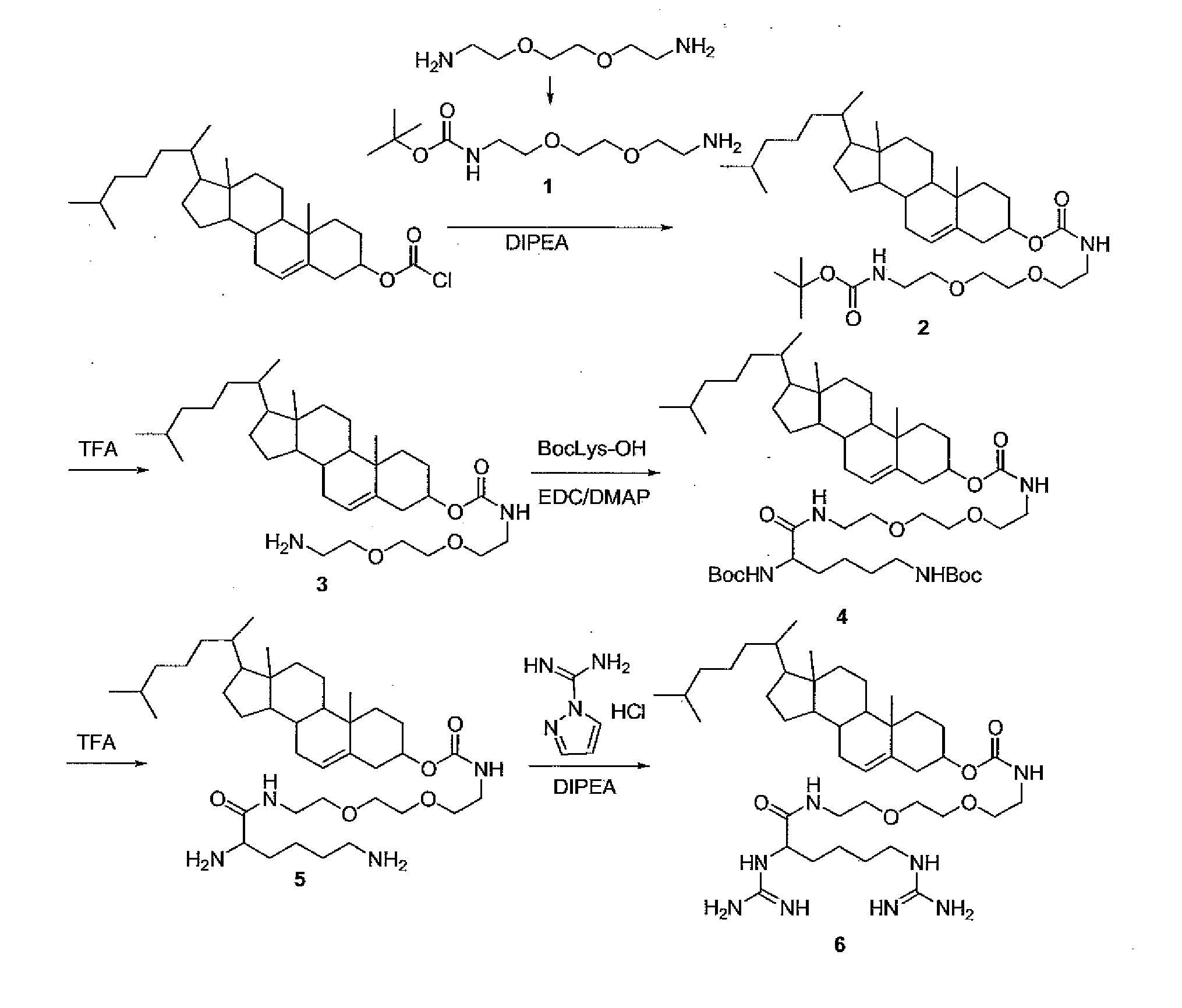Branched cationic lipids for nucleic acids delivery system
a nucleic acid and cationic lipid technology, applied in the direction of liposome delivery, dna/rna fragmentation, powder delivery, etc., can solve the problems of limited nucleic acid therapy, inability to effectively deliver oligonucleotides into the body, and inability to show significant improvement in vivo activities, etc., to achieve the effect of improving the cellular delivery of nucleic acids and potent down-modulation of the target m
- Summary
- Abstract
- Description
- Claims
- Application Information
AI Technical Summary
Benefits of technology
Problems solved by technology
Method used
Image
Examples
example 1
General NMR Method
[0605]1H NMR spectra were obtained at 300 MHz and 13C NMR spectra at 75.46 MHz using a Varian Mercury 300 NMR spectrometer and deuterated chloroform as the solvents unless otherwise specified. Chemical shifts (δ) are reported in parts per million (ppm) downfield from tetramethylsilane (TMS).
example 2
General mRNA Down-Regulation Procedure
[0606]Cells are maintained in a complete medium (F-12K or DMEM, supplemented with 10% FBS). A 12 well plate containing 2.5×105 cells in each well is incubated overnight at 37° C. The cells are washed once with Opti-MEM® and 400 μL of Opti-MEM® is added to each well. Then, the cells are treated with a nanoparticle solution encapsulating nucleic acids or a solution of free nucleic acids without the nanoparticles (naked oligonucleotides) as a control. The cells are incubated for 4 hours, followed by addition of 600 μL of media per well, and incubation for 24 hours. After 24 hours of the treatment, the intracellular mRNA levels of a target gene such as human ErbB3, and a housekeeping gene such as GAPDH are measured by RT-qPCR. The expression levels of mRNA are normalized to that of GAPDH.
example 3
Preparation of Compound 1
[0607]To a solution of 2,2′-(ethane-1,2-diylbis(oxy))diethanamine (101.2 g, 683 mmol) in 250 mL of anhydrous dichloromethane (DCM) and 200 mL of THF was added a solution of di-tert-butyl dicarbonate (59.6 g, 273 mmol) in 150 mL of anhydrous DCM at 0° C. slowly over a period of 1.5 hours. The mixture was stirred for 16 hours at room temperature. The solvent was removed and the residue was taken into 300 mL of water and extracted into DCM (2×300 mL) The organic layers were combined and extracted with 0.5N HCl (2×250 mL). The aqueous layer was then basified with a 4 N sodium hydroxide solution to pH 8 and extracted with DCM (2×300 mL). The organic layers were combined and dried over anhydrous magnesium sulfate, filtered, concentrated and dried under vacuum at 40° C. to yield 28.5 g (yield 42%) of product: 13C NMR d 155.43, 78.42, 73.05, 69.74, 41.37, 39.92, 28.06.
PUM
| Property | Measurement | Unit |
|---|---|---|
| size | aaaaa | aaaaa |
| temperature | aaaaa | aaaaa |
| temperature | aaaaa | aaaaa |
Abstract
Description
Claims
Application Information
 Login to View More
Login to View More - R&D
- Intellectual Property
- Life Sciences
- Materials
- Tech Scout
- Unparalleled Data Quality
- Higher Quality Content
- 60% Fewer Hallucinations
Browse by: Latest US Patents, China's latest patents, Technical Efficacy Thesaurus, Application Domain, Technology Topic, Popular Technical Reports.
© 2025 PatSnap. All rights reserved.Legal|Privacy policy|Modern Slavery Act Transparency Statement|Sitemap|About US| Contact US: help@patsnap.com



